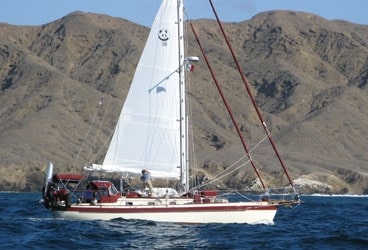
Panda 38 368
The respected Ta Shing Yard in Taiwan built the Panda 38 in the 1980s for Bob Berg and the Quicksilver Corporation. It was designed to be a lighter, faster, and smaller sibling to the Panda 40 while retaining the solid offshore capability for which Berg’s boats were known.
Designer Gary Grant gave the Panda 38 traditional lines that are accentuated by generous applications of teak used on the wide caprail, bronze-capped rubrail, grabrails, and cockpit coaming. Most of the boats were cutter rigged as a factory option and were fitted with a generous bowsprit. A vented teak platform attached to the bowsprit accommodates dual bronze anchor rollers.
Ta Shing’s interior teak joinery and craftsmanship is legendary. Aboard our Panda 38, Restless, we feel as though we live in a fine piece of furniture. The bulkheads are vertical teak staving; the overhead, between the laminated beams, is made of removable panels of laminate or spruce staving; locker doors are louvered teak. A teak grate at the foot of the companionway drains through a pan into the bilge.
The roomy and seaworthy U-shaped galley is to port of the companionway. On the starboard side, the forward-facing navigation station has adequate room for instrumentation and ample space in which to work. In some boats, the layout of galley and nav station was reversed.
The main saloon provides a generous area for living and entertaining, with a settee/sea berth to port and, to starboard, a U-shaped dinette that seats four comfortably. The master stateroom, in the bow, has a king-size V-berth. Aft of it, on the starboard side, the head has a marble countertop and a separate shower. Aft of the navigation station is a quarter berth.
Twelve old-school bronze opening ports, four cowl vents on teak dorade boxes, a forward-opening teak hatch in the V-berth, and an elegant teak butterfly hatch over the main cabin provide excellent airflow throughout the interior.
While the standard engine was the Universal 40-hp. diesel, some boats, including ours, have a Universal 50. The V-drive transmission leaks notoriously and has been replaced on many boats. Access to the engine area under the cockpit is outstanding.
Generous tankage permits extended cruising: A black-iron tank under the saloon sole carries 75 gallons of diesel, and two stainless-steel tanks under the settees hold 140 gallons of water between them.
The Panda 38’s teak decks are laid on top of a fiberglass sandwich. When we removed hardware to recaulk the deck, we found that the deck core is made of individual 2-inch balsa squares with resin barriers between them, which limits core damage when a leak occurs.
A moderate performer under sail, the P38 goes to weather pretty well even in light air. The boat will turn in 150 miles in 24 hours with 10 knots or more forward of the beam, but if it’s aft of the beam, the Panda needs more wind to perform in any significant sea state. The more wind, the more the 38 likes it. The boat has a sea-kindly motion and modest weather helm. The bathtub cockpit is rather small. We feel tucked in and safe when passagemaking, but it seats only four to six people comfortably at anchor.
Our Panda 38 has proven to be a strong and solid sailboat and a comfortable home. Ta Shing built 29 of them during the early 1980s. They’re rare; expect asking prices between $100,000 and $125,000, depending on equipment and whether the abundant teak is in a gray “natural state” or in show condition.
For more information, visit the Baba-Panda-Tashiba owners website (www.groups.yahoo.com/group/baba-l).
Mary Brandon “Brandy” Fox and her husband, Mark, sailed their Panda 38, Restless, from Seattle to Patagonia via California, Mexico, Ecuador, Easter Island, and Chile.
Specs
LOA 37′ 7″ (11.45 m.)
LWL 31′ 6″ (9.60 m.)
Beam 12′ 0″ (3.66 m.)
Draft 5′ 9″ (1.75 m.)
Sail Area (100%) 704 sq. ft. (65.40 sq. m.)
Ballast 6,600 lb. (2,993 kg.)
Displacement 19,000 lb. (8,617 kg.)
Ballast/D .35
D/L 271
SA/D 15.8
Water 140 gal. (531 l.)
Fuel 75 gal. (284 l.)
Engine Universal 40-hp. diesel
Designer Gary Grant








